Navigating Stakeholder Analysis: Power-Interest Model vs. Salience Model
Among the most prominent frameworks for stakeholder analysis are the Power-Interest Model and the Salience Model. Each offers unique perspectives and insights, but understanding their differences and applications is key to leveraging them for project success. This article explores the distinctions between these models and provides guidance on how BAs and POs can choose the most suitable one for their projects, whether in Agile or Waterfall environments.
The Power-Interest Model
The Power-Interest Model is a stakeholder analysis tool that categorizes stakeholders based on two key dimensions: their power to influence the project and their level of interest in the project's outcomes. This model typically results in a four-quadrant matrix:
1. High Power, High Interest: Stakeholders who are both influential and keenly interested in the project. They are key players who require close engagement and regular communication.
2. High Power, Low Interest: Stakeholders with significant influence but limited interest. They need to be kept satisfied but may not require detailed, frequent updates.
3. Low Power, High Interest: Stakeholders with high interest but limited power. They should be kept informed and can often be valuable sources of support and insight.
4. Low Power, Low Interest: Stakeholders with minimal interest and influence. Minimal effort is required, often limited to monitoring or periodic updates.
The Salience Model
The Salience Model, on the other hand, offers a more nuanced approach by considering three attributes: Power, Legitimacy, and Urgency.
1. Power: Similar to the Power-Interest Model, this dimension assesses the stakeholder's ability to influence the project.
2. Legitimacy: This attribute evaluates the legitimacy of the stakeholder's relationship with the project, including their rightful involvement and concerns.
3. Urgency: This aspect considers the immediacy of the stakeholder's needs or demands, emphasizing time-sensitive interests.
Stakeholders are evaluated based on the presence or absence of these attributes, leading to various combinations that highlight different levels of stakeholder salience.
Choosing Between the Models for Project Success
The choice between the Power-Interest Model and the Salience Model depends on several factors, including the project's complexity, the environment, and specific stakeholder dynamics. Here's how BAs and POs can decide which model to use:
- Project Complexity: For projects with a broad and diverse stakeholder landscape, the Salience Model may offer a more detailed analysis due to its three-dimensional approach, making it easier to identify stakeholders who might not be obvious in a Power-Interest matrix.
- Stakeholder Dynamics: If stakeholder interests and power dynamics are relatively straightforward, the Power-Interest Model might suffice. However, if stakeholders have complex relationships with the project or urgent needs, the Salience Model's additional dimensions of Legitimacy and Urgency can provide deeper insights.
- Project Environment: In fast-paced Agile environments where stakeholder interests and priorities may shift rapidly, the Salience Model's emphasis on Urgency can be particularly beneficial. In more traditional Waterfall projects, where stakeholder positions and power dynamics are well-defined and stable, the Power-Interest Model might be more applicable.
- Communication Strategies: The choice of model can also inform communication strategies. The Power-Interest Model is effective for developing straightforward communication plans based on stakeholders' power and interest levels. In contrast, the Salience Model can guide more nuanced engagement strategies that consider legitimacy and urgency, alongside power and interest.
Selecting the Right Model
Both the Power-Interest Model and the Salience Model are valuable tools in the BA and PO's toolkit, offering structured approaches to stakeholder analysis. The choice between them should be guided by the specific needs of the project, the nature of the stakeholder landscape, and the goals of the stakeholder engagement strategy. By carefully selecting and applying the most appropriate model, BAs and POs can enhance their stakeholder management efforts, leading to more informed decision-making, better communication, and ultimately, more successful project outcomes in both Agile and Waterfall environments.
Unlock your full potential as a Business Analyst with our game-changing online course! Tailored for the analytical minds eager to lead, innovate, and transform, this course is your gateway to mastering the most effective business analysis techniques. Whether you're looking to excel in Agile, shine in Waterfall, or innovate in uncharted territories, our expert-led curriculum is designed to elevate your skills, boost your career, and make you the go-to strategist in any room. Join us, and become the catalyst for change your organization didn't know it needed!
Ready to up your business analyst game? Let’s explore 7 powerful techniques that are shifting the business analysis landscape with expert insight from business analysis pros.
7 Powerful Analysis Techniques Book
Amazon Kindle $9.99
Uncommon Book of Analysis Techniques Book
PDF Download $75.00



